Glaucoma in dogs is a pressing concern that demands vigilance and proactive management. The presence of cloudy eyes should serve as a pivotal signal prompting a visit to your pup's veterinarian.
However, the implications extend far beyond mere cloudiness. Understanding the intricacies of this condition, the potential ramifications, and the importance of timely intervention are crucial components in safeguarding your furry companion's ocular health.
Stay tuned to discover the nuances of glaucoma in dogs and the indispensable role veterinary care plays in preserving their vision and overall well-being.
Key Takeaways
- Cloudy eyes in dogs could signal glaucoma, a serious condition requiring immediate veterinary attention.
- Regular eye exams are crucial for early detection and prevention of vision loss in dogs.
- Immediate treatment with medications, surgery, or other therapies is essential for managing glaucoma.
- Early diagnosis and intervention improve the prognosis for dogs with glaucoma, helping preserve their eye health.
Understanding Glaucoma in Dogs
An in-depth comprehension of glaucoma in dogs entails recognizing the intricate interplay between intraocular pressure and the accumulation of aqueous humor in the eye. Glaucoma is characterized by elevated intraocular pressure, which can lead to optic nerve damage and vision loss if left untreated.
Understanding the two main types of glaucoma, primary and secondary, is essential. Primary glaucoma can be further classified as open-angle or closed-angle and is often inherited, while secondary glaucoma results from underlying eye conditions.
Breeds like Cocker Spaniels, Poodles, Beagles, and Terriers are genetically predisposed to glaucoma. Blocked drainage of aqueous humor is a primary cause of glaucoma in dogs, emphasizing the importance of regular eye exams and early detection to prevent irreversible vision impairment.
Signs and Symptoms of Glaucoma
Understanding the signs and symptoms of glaucoma in dogs is paramount for timely detection and effective management of this ocular condition, ensuring the preservation of eye health and vision in our canine companions. Cloudy eyes, often the most noticeable sign, can indicate increased intraocular pressure. Other symptoms include drooping eyelids, redness, pain, vision changes, dilated pupils, and in severe cases, blindness.
Dogs may also exhibit behavioral changes like increased sensitivity to light or rubbing their eyes. Prompt recognition of these signs is crucial for seeking veterinary care and preventing irreversible damage. Regular observation of your dog's eye health and behavior can aid in early detection and intervention, ultimately improving the prognosis for dogs with glaucoma.
Diagnosis and Veterinary Evaluation
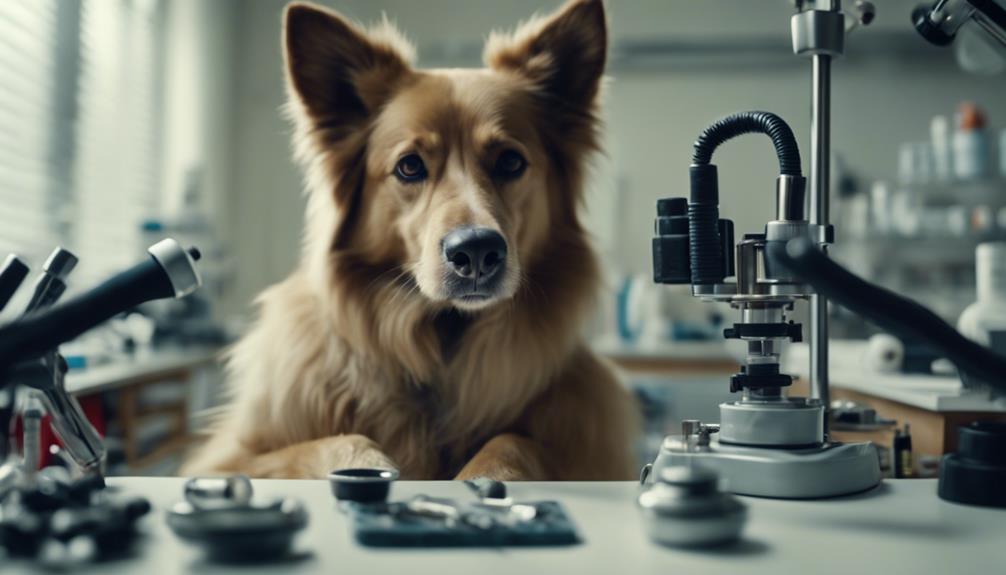
Upon presentation of a dog showing potential signs of glaucoma, a comprehensive veterinary evaluation involving precise intraocular pressure measurement and advanced ocular assessments is imperative for an accurate diagnosis and treatment plan.
Key Points:
- Intraocular Pressure Measurement: Crucial for confirming glaucoma diagnosis.
- Advanced Ocular Assessments: Help identify underlying causes and assess overall eye health.
- Specialized Eye Tests: Conducted by veterinary ophthalmologists to evaluate optic nerve damage and visual field changes.
Prompt diagnosis through these evaluations is essential as glaucoma can progress rapidly, leading to irreversible vision loss. Early intervention based on a thorough veterinary assessment can significantly improve the outcome and quality of life for dogs affected by this condition.
Immediate Treatment for Glaucoma
Effective treatment for glaucoma in dogs requires prompt and specialized interventions to alleviate intraocular pressure and prevent irreversible vision loss. Immediate treatment typically involves the administration of medications such as topical or oral pressure-lowering drugs like carbonic anhydrase inhibitors, beta-blockers, or prostaglandin analogs.
These medications aim to reduce intraocular pressure and manage pain associated with glaucoma. In cases of acute glaucoma, emergency procedures like paracentesis may be performed to quickly decrease pressure within the eye. It is crucial to consult a veterinarian promptly to determine the most suitable treatment plan for the individual dog's condition.
Delay in seeking treatment can result in rapid progression of glaucoma and irreversible damage to the eyes.
Surgical Options and Therapies
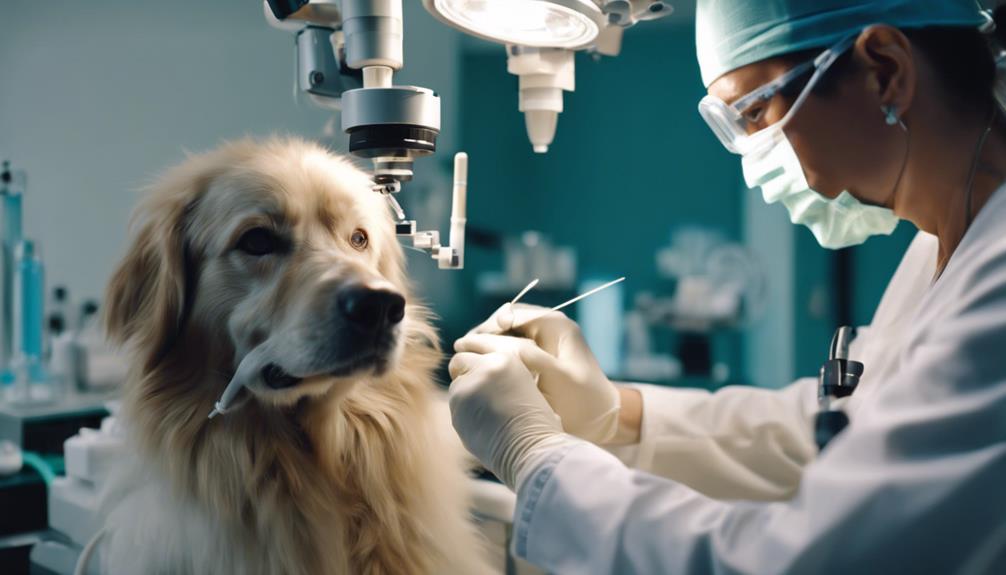
In cases where immediate treatment through medications may not sufficiently alleviate intraocular pressure, surgical options and therapies become essential for effective management of glaucoma in dogs. Surgical interventions aim to reduce intraocular pressure and alleviate pain to preserve the dog's vision and overall eye health.
Some common surgical options and therapies include:
- Trabeculectomy: A surgical procedure that creates a drainage channel in the eye to facilitate the outflow of aqueous humor.
- Cyclocryotherapy: Involves freezing the ciliary body to reduce aqueous humor production and lower intraocular pressure.
- Goniovalve implantation: A device surgically implanted to improve drainage and regulate intraocular pressure in dogs with glaucoma.
Management of Long-Term Care
Regular monitoring and diligent care are essential components of ensuring the long-term well-being of dogs diagnosed with glaucoma. Dogs with glaucoma require ongoing management to control intraocular pressure and prevent further damage to the eyes.
Owners should work closely with their veterinarian to develop a comprehensive treatment plan tailored to their pet's specific needs. This plan may include regular eye exams, administration of medications, and potential surgical interventions. Monitoring for any changes in symptoms, such as increased tearing, redness, or cloudiness in the eyes, is crucial for timely adjustments to the treatment regimen.
Prognosis and Adaptation for Dogs
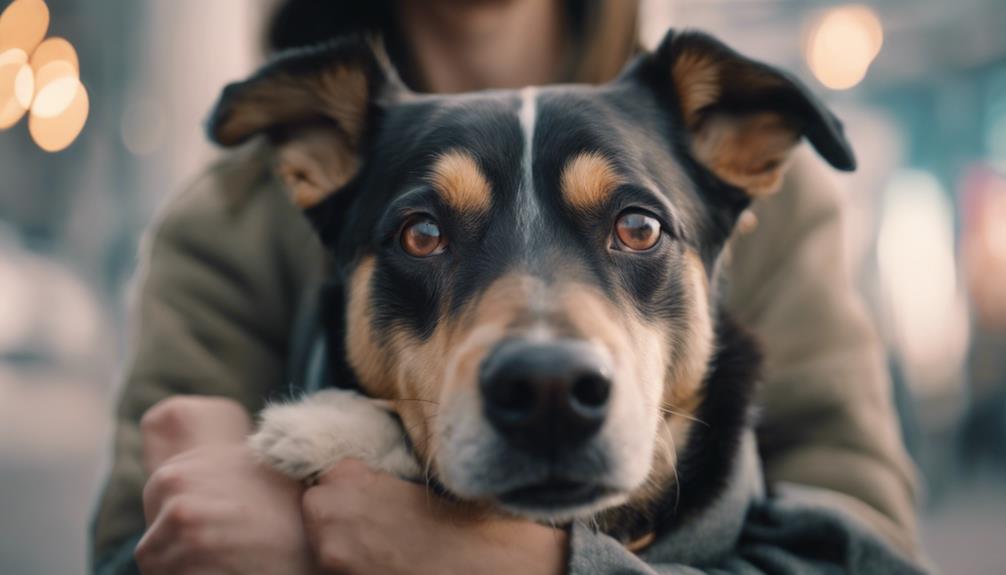
For dogs diagnosed with glaucoma, understanding the prognosis and the potential for adaptation is crucial in providing comprehensive care and support for their eye health.
Prognosis and Adaptation for Dogs:
- Prognosis:
- Glaucoma has no cure, but with proper treatment, it can be managed effectively.
- Long-term therapy may lead to blindness, but dogs have a remarkable ability to adapt to vision loss.
- Regular monitoring and veterinary care play a key role in managing the condition and preserving eye health.
Dogs diagnosed with glaucoma can lead fulfilling lives with the right care and support, emphasizing the importance of proactive management and regular veterinary check-ups.
Risk Factors for Glaucoma
Understanding the risk factors associated with glaucoma in dogs is crucial for early detection and effective management of this sight-threatening condition. Certain factors can increase a dog's susceptibility to developing glaucoma, including breed predisposition, age, genetics, previous eye injuries, and other existing ocular conditions. Regular monitoring of intraocular pressure and adherence to veterinary recommendations are vital for prevention. Being attentive to common signs such as cloudy eyes, increased tearing, redness, pain, and alterations in eye appearance can aid in early detection. Maintaining overall eye health through routine eye exams is essential for preventing vision loss in dogs.
| Risk Factors for Glaucoma in Dogs | Examples |
|---|---|
| Breed predisposition | Cocker Spaniels, Poodles, Beagles, Terriers |
| Advanced age | Older dogs are more prone to developing glaucoma |
| Genetics | Inherited conditions can increase the risk |
| Previous eye injuries | Trauma to the eye can lead to glaucoma |
Prevention Strategies for Dog Owners
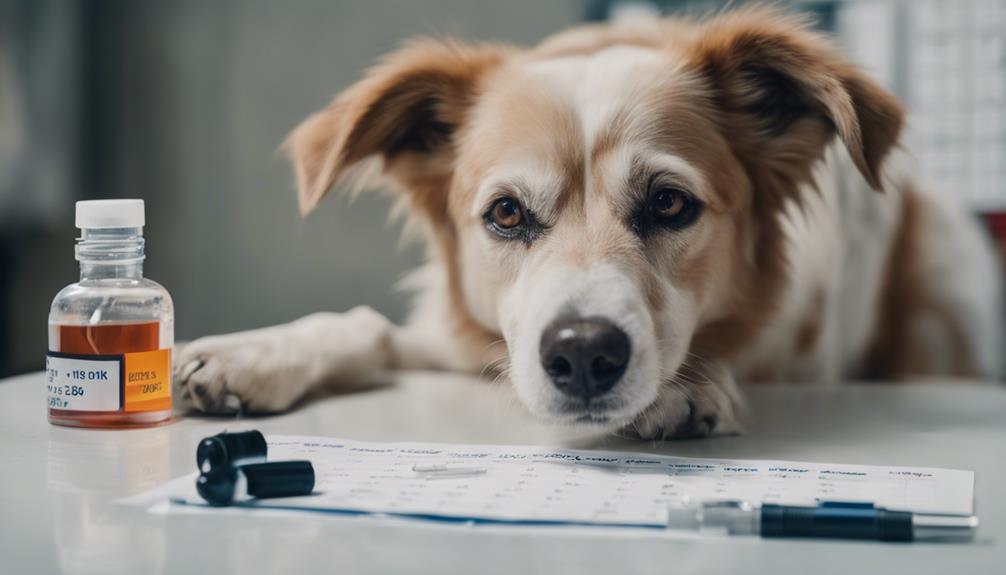
To safeguard their canine companions from the risks of glaucoma, dog owners should prioritize proactive measures aimed at preventing the onset and progression of this potentially sight-threatening condition. Implementing the following strategies can significantly reduce the likelihood of glaucoma development in dogs:
- Regular Eye Exams: Schedule routine eye check-ups with a veterinarian to monitor your dog's eye health and detect any early signs of glaucoma.
- Maintaining Healthy Weight: Obesity can contribute to various health issues, including glaucoma. Ensure your dog maintains a healthy weight through proper diet and regular exercise.
- Environmental Awareness: Be cautious of potential eye irritants or injuries in your dog's environment to prevent eye damage that could lead to glaucoma.
Breed Predisposition and Genetic Factors
What genetic factors contribute to the breed predisposition for glaucoma in dogs?
Certain dog breeds have a higher predisposition to develop glaucoma due to genetic factors. Breeds such as Cocker Spaniels, Poodles, Beagles, and Terriers are known to be genetically predisposed to this condition.
The inheritance of specific anatomical structures within the eye, like the drainage angle, can contribute to the increased risk of developing glaucoma in these breeds.
Understanding the genetic basis of glaucoma in dogs can help veterinarians tailor their approach to diagnosing and managing the condition in at-risk breeds. By recognizing these genetic factors, veterinarians can provide more targeted care and early intervention to improve the prognosis for dogs predisposed to glaucoma.
Importance of Regular Eye Exams
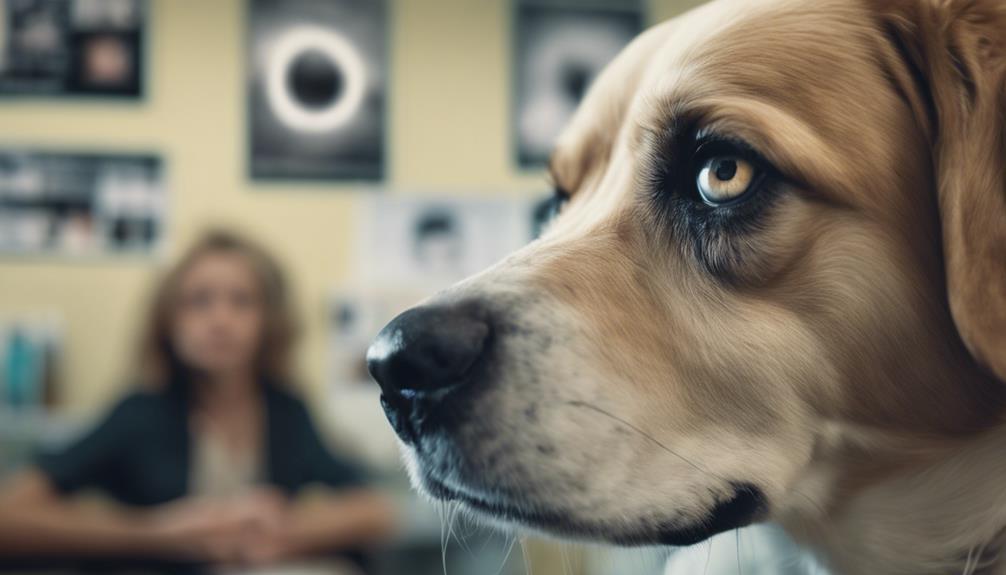
Regular eye exams play a crucial role in the early detection and monitoring of glaucoma in dogs. These exams are essential for assessing the overall eye health of your furry companion and catching any potential issues, such as glaucoma, in their early stages. Here are three reasons why regular eye exams are important for dogs:
- Early Detection: Regular eye exams help veterinarians identify glaucoma or other eye conditions before they progress, allowing for prompt intervention.
- Monitoring Changes: Through regular exams, changes in your dog's eyes can be monitored over time, providing valuable information about their eye health status.
- Preventive Care: Routine eye check-ups can help prevent vision loss by addressing any developing issues early on, ensuring the best possible outcome for your pet's eye health.
Monitoring Intraocular Pressure
Given the significance of maintaining optimal eye health in dogs, one essential aspect of their ocular wellness involves the meticulous monitoring of intraocular pressure. Monitoring intraocular pressure is crucial in the early detection and management of glaucoma, a condition characterized by increased pressure within the eye.
Veterinary ophthalmologists typically measure intraocular pressure using tonometry, a procedure that assesses the fluid pressure inside the eye. Regular monitoring of intraocular pressure is vital for dogs at risk of glaucoma, especially those with a genetic predisposition or a history of eye conditions.
Early Intervention and Detection
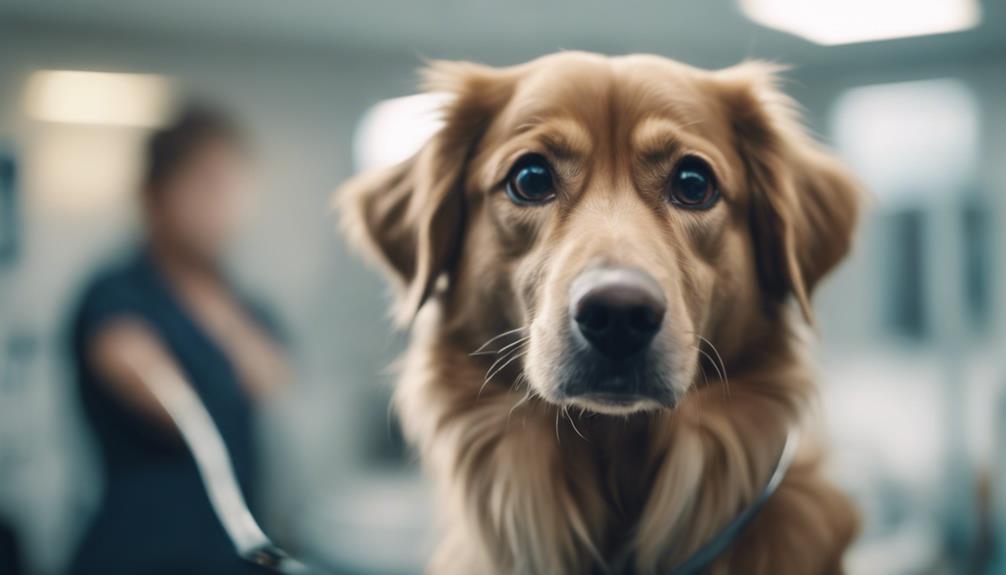
For effective management of glaucoma in dogs, prompt detection and intervention play a critical role in preserving the dog's vision and overall eye health. Early identification of glaucoma symptoms and timely treatment can significantly impact the prognosis for dogs with this condition.
Here are key points to highlight the importance of early intervention and detection:
- Regular Eye Exams: Scheduled check-ups can help catch glaucoma in its early stages before irreversible damage occurs.
- Prompt Veterinary Attention: Immediate consultation with a veterinarian upon observing any signs of glaucoma is crucial for timely diagnosis and treatment.
- Awareness and Observation: Educating dog owners about common symptoms and encouraging vigilant monitoring of their pet's eye health can aid in early detection and intervention.
Preserving Canine Eye Health
Preservation of canine eye health is fundamental to ensuring optimal vision and well-being in dogs. Regular veterinary check-ups focusing on eye health are essential for early detection of any potential issues.
Maintaining a clean environment and preventing eye injuries can help safeguard your dog's vision. Providing a balanced diet with essential nutrients like Vitamin A, Omega-3 fatty acids, and antioxidants can promote overall eye health.
Additionally, keeping your dog at a healthy weight and ensuring they get regular exercise can contribute to their eye health. Avoiding exposure to harmful chemicals, cigarette smoke, and UV radiation can also help prevent eye problems.
Conclusion
In conclusion, glaucoma in dogs is a serious ocular condition that requires prompt diagnosis and intervention to prevent irreversible vision loss.
With diligent monitoring, adherence to prescribed care regimens, and regular veterinary consultations, canine eye health can be safeguarded.
Recognizing predisposing factors, addressing concerning ocular changes swiftly, and maintaining awareness of the importance of early intervention are crucial in preserving vision and overall well-being in dogs.




